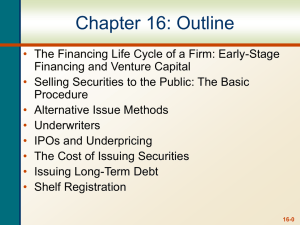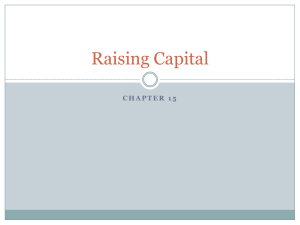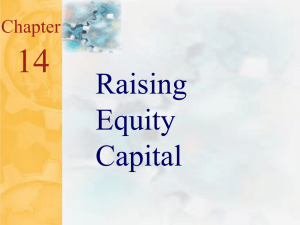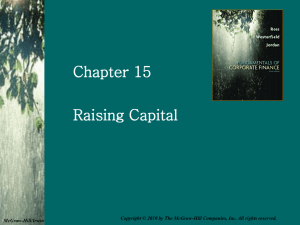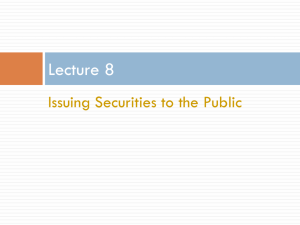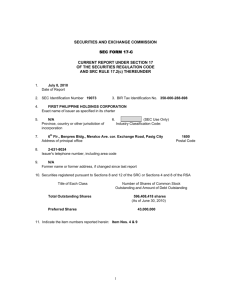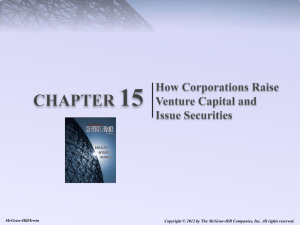RAISING CAPITAL
advertisement
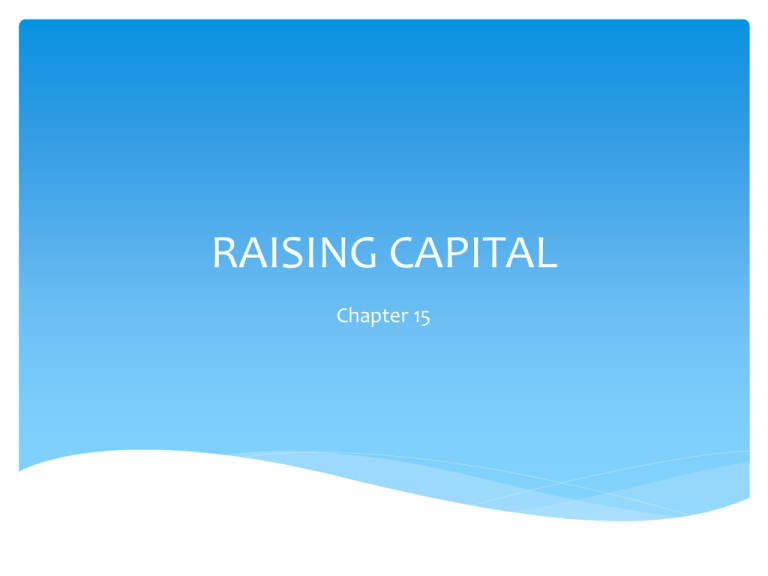
RAISING CAPITAL Chapter 15 Introduction Definition of capital: borrowed sums or equity with which the firm's assets are acquired and its operations are funded. When does a firm need capital? New or start up companies Finance expansion Rapid growth Opening new market lines Mergers and acquisitions Introduction How can a firm raise money?? 1. Equity: selling a portion of the firm to investors so the investor would be the owner of that portion of the firm in the form of common stock or preferred stock. 2. Debt: An amount owed to a person or organization for funds borrowed. Debt can be represented by a loan note, bond, mortgage or other form stating repayment terms and interest requirements. How a firm raises capital depends on the size of the firm, the life cycle stage, and the growth prospects of the firm. 1- The Financing Life Cycle of a Firm: Early-Stage Financing and the Importance of Venture Capital Venture Capital Financing for new, often high-risk venture. Private Equity: is often used to label the rapidly growing areas of equity financing for nonpublic companies. Capital for new firms Can new start-up firms rely on bank loans for capital? Venture capital: general term for financing startup, early stage, and "turn around" type businesses Sources of VC New business will be risky What does Venture capitalist do to avoid this risk? Why might Venture capitalist be willing to take this risk? Venture capital firm often specialize in different stage. Some specialize in very early “seed money or ground floor” financing. Financing in the late stages might come from venture capitalist specializing in so-called mezzanine-level financing (mezzanine level refers to the level just above the ground floor). Choosing a venture capital 1. 2. 3. 4. 5. Financing strength is important. Style is important. References are important. Contacts are important. Exit strategy is important. 2- SELLING SECURITIES TO THE PUBLIC 1. The first step is to obtain approval from the board of directors 2. The second step is to prepare a registration statement and file it with the SEO “Securities and Exchange Commission” The registration statement is required for all public, interstate issues of securities, with two exceptions: a. Loan that mature within nine months. b. Issue the involve less than $5 million. 3. The SEO examine the registration statement during a waiting period. During this time, the firm may distribute copies of a preliminary prospectus. The prospectus: contain much of the information in the registration statement, and it is given to potential investors by the firm. 4. The company cannot sell these securities during the waiting period. While and after the waiting period, an advertisement announcing a public offering is used by underwriters and called Tombstone. 3- ALTARNATIVE ISSUE METHODS When a company decides to issue a new security, it can sell it as public issue or a private issue (less than 35 investor) In the case of a public issue, the firm is required to register the issue with the SEC. For equity sale, there are two kinds of public issue 1. General cash offer. 2. Rights offer. With the cash offer, securities are offered to the general public . With the rights offer, securities are initially offered only to existing owners. The first public equity issue that is made by the company is referred to as an initial public offering, IPO. This issue occurs when a company decides to go public. A seasoned equity offering (SEO) is new issue a company with securities that have been previously issued. A seasoned equity offering of common stock can be made by using a cash offer or a rights offer. 4- UNDERWRITERS Definition: investment firms that act as intermediaries between a company selling securities and the investing capital Services provided by underwriters Formulate method used to issue securities Price the securities Sell the securities Price stabilization by lead underwriter Underwriters Syndicate – group of investment bankers that market the securities and share the risk associated with selling the issue Spread – difference between what the syndicate pays the company and what the security sells for initially in the market The underwriter buys the securities for less than the offering price and accepts the risk of not being able to sell them. Because underwriting involves risk, underwriters usually combine to from an underwriting group called a syndicate to share the risk and to help sell the issue. The difference batten the underwriter's buying price and the offering price is called the Gross spread, or underwriting discount. It is the basic compensation received by the underwriter. Sometime, on smaller deals, the underwriter will get noncash compensation in the form of warrants and stock in addition to the spread. Types of underwriting 1. Firm Commitment Underwriting Issuer sells entire issue to underwriting syndicate The syndicate then resells the issue to the public The underwriter makes money on the spread between the price paid to the issuer and the price received from investors when the stock is sold The syndicate bears the risk of not being able to sell the entire issue for more than the cost Types of underwriter 2. Best efforts underwriting Underwriter must make their “best effort” to sell the securities at an agreed-upon offering price The company bears the risk of the issue not being sold Not as common as it used to be Types of underwriter 3. Dutch auction underwriting: Underwriter accepts a series of bids that include number of shares and price per share Google was the first large Dutch auction IPO IPOs & under pricing Initial Public Offering – IPO May be difficult to price an IPO because there isn’t a current market price available Under pricing causes the issuer to “leave money on the table” Why Does Underwriting Exist?? To attract investors for young firms To act as an Insurance for the investment bank A way that a bank can reward investors for reveling what they think the stock worth and the numbers of shares they would like to buy THE COST OF ISSUING SECURITIES 1. Gross spread: The gross spread consists of direct fees paid by the issuer to the underwriting syndicate- the different between the price the issuer receive and the offer price. 2. Other direct expenses: these are direct cost, incurred by the issuer, that are not part of the compensation underwriters. These cost include filing fees, legal fees, and tax … etc. THE COST OF ISSUING SECURITIES 3. Indirect expenses: these cost are not reported on the prospectus and include the cost of management time spent working on the new issue. 4. Abnormal return: in seasoned issue of stock, the price of the existing stock drop on average by 3% on the announcement of the issue. This drop is called the abnormal return. THE COST OF ISSUING SECURITIES 5. Under pricing: For initial public offering, losses arise from selling the stock below the true value. 6. Green shoe option: It gives the underwriters the right to buy additional shares at the offer price to cover overallotment. Rights Definition: an issue of common stock offered to existing stockholders “Rights” are given to the shareholders Specify number of shares that can be purchased Specify purchase price Specify time frame Why do companies offer Rights? (Advantages) Rights may be traded OTC or on an exchange Rights The mechanics of a rights offering Number of rights needed to purchase a share The value of a right Example: National Power current share price is 20$, there is 1,000,000 shares outstanding. Suppose they want to raise 5,000,000$ in new equity using a right offering (1 right for each 1 share) with a subscription price of 10$. Calculate the following: 1. Number of new shares to be issued 2. Number of rights needed to buy a new share 3. The value of the right 4. Show in calculations the effects of the rights offering on shareholders The value of a right Results The price specified in a rights offering is generally less than the current market price The share price will adjust based on the number of new shares issued The value of the right is the difference between the old share price and the “new” share price Rights Offering Example Suppose a company wants to raise $10 million. The subscription price is $20 and the current stock price is $25. The firm currently has 5,000,000 shares outstanding. How many shares have to be issued? How many rights will it take to purchase one share? What is the value of a right? Dilution Dilution is a loss in value for existing shareholders that occurs through the issuance of additional stocks Dilution kinds: 1. Percentage ownership – shares sold to the general public without a rights offering 2. Market value – firm accepts negative NPV projects 3. Book value and EPS – occurs when market-to-book value is less than one Issuing Long-term Debt Types of Long-term Debt 1. Public issue of long-term debt are usually in the form of bonds 2. Private issues Long-Term loans usually bank loans or could be from private firm which has a history with the company Easier to renegotiate than public issues If bonds were issued to private investors costs would be lower than public issues MORE THAN 50% OF ALL DEBT ARE ISSUED PRIVATELY Interest rates are higher in private issues when compared to public issues Ex 1 Page 505 Big Time, Inc., is proposing a rights offering. Presently there are 500,000 shares outstanding at 81$ each. There will be 60,000 new shares offered at 70$ each. A. What is the new market value of the firm B. How many rights are associated with one of the new shares? C. What is the value of a right? D. Why might a company have a rights offering rather than a general cash offer?
